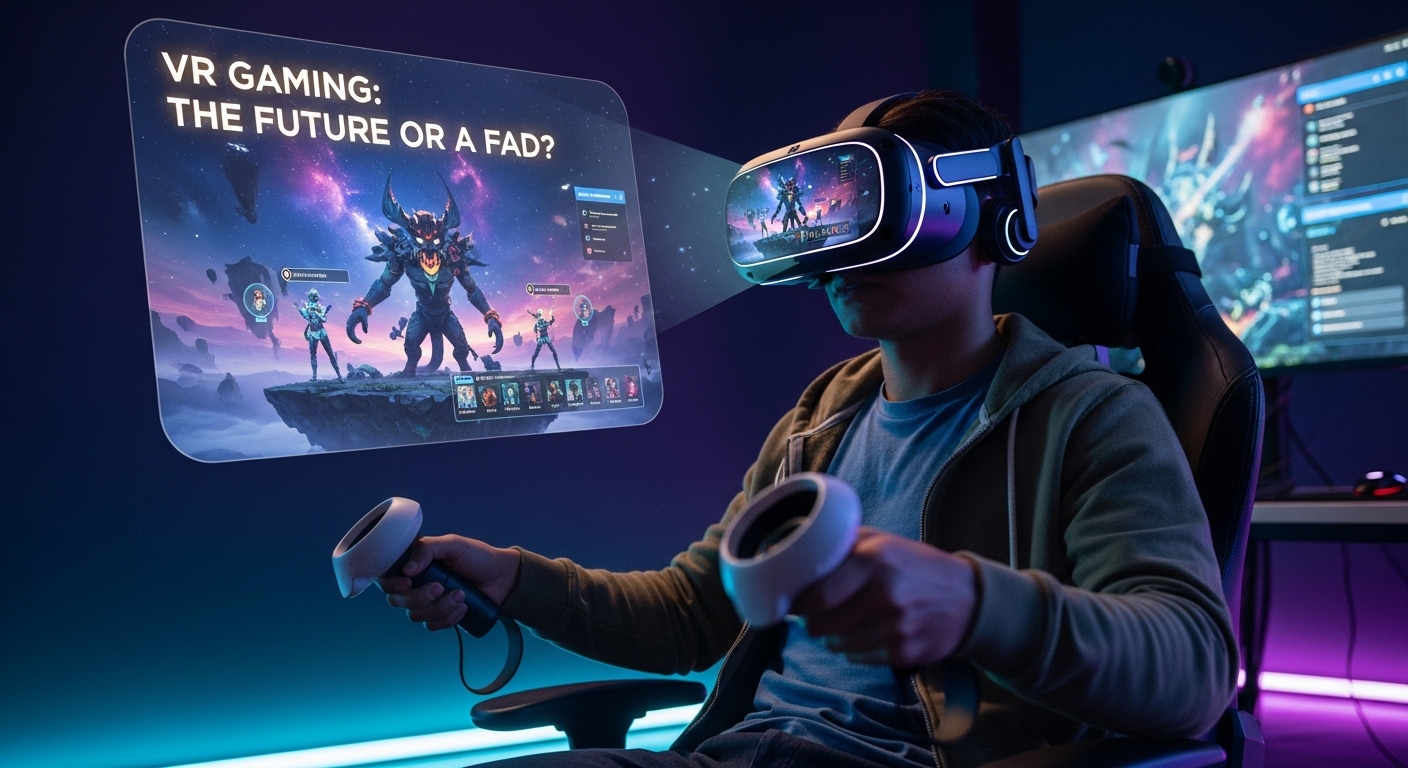Introduction to the Concept of VR Gaming
Virtual Reality gaming, often abbreviated as VR gaming, represents one of the most significant technological shifts in the entertainment industry. It provides an immersive experience by allowing players to step into a digital environment and interact with virtual worlds in ways that traditional consoles, PCs, and mobile devices cannot achieve. From strapping on a headset to holding motion controllers, the user transitions from a passive viewer to an active participant, breaking down the barrier between reality and the digital space. With its rise in popularity over the past decade, a critical question emerges: is VR gaming the undeniable future of interactive entertainment, or is it merely a passing fad that will fade away like other short-lived innovations?
The Evolution of Virtual Reality in Gaming
The roots of VR gaming can be traced back decades, with early prototypes like Nintendo’s Virtual Boy in the 1990s attempting to offer three-dimensional gameplay experiences. However, due to technological limitations and lack of consumer readiness, early VR efforts largely failed. The resurgence of VR began in the early 2010s, fueled by the introduction of the Oculus Rift prototype, which reignited public and investor interest in immersive gaming. Since then, major players such as HTC with its Vive, Sony with PlayStation VR, and Meta with Quest headsets have brought VR into mainstream conversations. The evolution of hardware and software has pushed VR beyond a niche technology into a rapidly expanding sector of the gaming industry.
The Core Appeal of VR Gaming
At the heart of VR gaming’s appeal is immersion. Unlike conventional gaming, where players watch the action unfold on a screen, VR places them directly inside the game world. Imagine walking through a haunted house where the shadows shift as you turn your head, or exploring a fantasy land where you can swing a sword with your own hands rather than pressing a button. This immersion creates emotional connections, adrenaline rushes, and a sense of presence that no traditional medium can fully replicate. It appeals not only to gamers but also to individuals seeking experiences such as virtual tourism, fitness, and even social interaction.
The Technological Advancements Driving Growth
One of the biggest reasons VR gaming continues to expand is the rapid improvement in hardware. Modern headsets have higher resolutions, wider fields of view, and lower latency than their predecessors. These advancements reduce motion sickness, a common barrier in earlier VR systems, and create more realistic visuals. Additionally, wireless headsets like the Meta Quest series have removed the need for bulky cables, making VR more accessible and user-friendly. Combined with powerful gaming PCs and consoles, as well as advancements in cloud streaming, the technology driving VR is becoming more refined, paving the way for more mainstream adoption.
The Role of Content in VR’s Success
No gaming platform can succeed without compelling content, and VR is no exception. Popular titles such as Beat Saber, Half-Life: Alyx, and Resident Evil 4 VR have demonstrated how VR can transform established gaming genres into fresh experiences. Beyond games, VR offers applications like VRChat, Rec Room, and Horizon Worlds, where users socialize and create shared virtual spaces. The variety and quality of content available will play a significant role in determining whether VR is the future of gaming or a fad that fails to maintain long-term consumer interest.
Accessibility and the Barrier of Cost
One of the challenges VR gaming faces is accessibility. High-end VR systems often require powerful gaming PCs or consoles in addition to the cost of the headset itself. For many consumers, the combined price is simply too high. While standalone VR devices have helped lower the barrier, they still represent a significant investment compared to traditional gaming consoles. Until VR hardware becomes as affordable and convenient as mainstream gaming platforms, widespread adoption may remain out of reach for many households.
The Social Dimension of VR Gaming
Gaming has always been a social activity, whether through couch co-op experiences or massive online multiplayer titles. VR gaming introduces a new level of social interaction by allowing players to embody avatars and communicate in virtual spaces. Hand-tracking, voice interaction, and realistic avatars create a sense of presence with others that goes beyond what a standard screen can offer. However, VR social platforms also face challenges such as moderation, inclusivity, and safety, which must be addressed for long-term sustainability.
VR in Esports and Competitive Gaming
Esports has grown into a billion-dollar industry, and VR has the potential to carve out a unique niche within it. Competitive VR games require not just strategic thinking but also physical movement, creating an entirely different competitive landscape. Games like Echo Arena and VR shooter competitions highlight the potential for a new wave of esports where physical skill and digital gameplay intersect. However, VR esports still struggles to gain the same level of viewership and mainstream recognition as traditional gaming tournaments, raising questions about its potential longevity.
The Health and Fitness Aspects of VR Gaming
Unlike traditional gaming, which often involves long hours of sitting, VR gaming promotes physical activity. Many VR games require players to move, duck, punch, and swing, which contributes to physical exercise. Fitness-focused VR applications such as Supernatural and FitXR are becoming increasingly popular, blending gaming with workout routines. This unique combination of entertainment and exercise could make VR an essential tool for promoting healthier lifestyles, adding another layer to its potential as the future of interactive media.
Psychological and Educational Benefits of VR Gaming
Beyond entertainment, VR gaming offers psychological and educational benefits. It can be used to train individuals in real-world scenarios, teach problem-solving skills, and even help with mental health therapy through exposure techniques. For education, VR offers students immersive experiences like walking through historical sites, exploring space, or practicing medical procedures. If integrated with gaming, these applications could transform how people learn and interact with information, making VR a multi-dimensional platform rather than a fleeting trend.
The Challenges Facing VR Gaming
Despite its potential, VR gaming faces significant challenges. Motion sickness remains a barrier for some players, even with improved hardware. The lack of standardized development tools across different VR platforms can fragment the market. Furthermore, VR still struggles with practical issues like headset comfort, battery life, and physical space requirements. Without addressing these obstacles, VR risks remaining a niche product for enthusiasts rather than achieving mainstream adoption.
The Competition with Traditional Gaming
Traditional gaming continues to dominate the industry with consoles, PCs, and mobile platforms generating billions in revenue each year. These platforms are familiar, convenient, and accessible to wide audiences. While VR offers unique experiences, it has yet to replace or match the convenience of traditional gaming. Many gamers see VR as a complementary experience rather than a replacement, raising questions about whether VR will ever fully overtake conventional gaming systems.
The Cultural Shift Toward Immersive Entertainment
One of the most compelling arguments for VR being the future lies in the cultural shift toward immersive experiences. From theme parks using VR rides to businesses conducting virtual meetings, society is increasingly adopting immersive technologies. Younger generations, in particular, are growing up in an era where virtual worlds and digital interactions are commonplace. This cultural acceptance of immersive entertainment could help push VR gaming further into the mainstream, making it a long-term fixture rather than a temporary trend.
The Future of VR Hardware and Innovation
Looking ahead, the future of VR hardware appears promising. Companies are developing lighter, more comfortable headsets with better graphics and haptic feedback systems. Innovations such as full-body tracking, tactile gloves, and augmented reality integrations could further blur the line between the virtual and physical worlds. As hardware evolves, so too will the quality of VR games, ensuring deeper immersion and more engaging gameplay experiences.
The Potential Impact of the Metaverse
The rise of the metaverse concept has also placed VR gaming in the spotlight. With companies investing heavily in creating shared, persistent virtual worlds, VR serves as the natural gateway to these environments. Gamers may eventually transition seamlessly from playing VR games to working, socializing, and even shopping within the metaverse. While still in its early stages, the metaverse has the potential to redefine not only gaming but the entire digital ecosystem, positioning VR as an essential component of the future.
The Argument for VR as the Future
Supporters of VR argue that its unique ability to immerse players makes it the next logical step in gaming evolution. Just as games transitioned from 2D to 3D worlds, VR represents the next frontier. Its applications extend beyond entertainment to fitness, education, and social connectivity, making it a versatile and future-proof platform. The constant investment from major tech companies indicates strong belief in VR’s long-term potential, suggesting it is far from being just a passing fad.
The Argument for VR as a Fad
On the other hand, critics argue that VR faces too many barriers to become mainstream. High costs, physical discomfort, space requirements, and limited content libraries make it less appealing to casual gamers. History is filled with once-hyped technologies that failed to achieve mass adoption, from motion control peripherals to 3D televisions. Without solving its fundamental accessibility issues, VR risks joining this list of short-lived innovations, appealing primarily to enthusiasts rather than the broader market.
The Balance Between Future and Fad
Perhaps the truth lies somewhere in between. VR gaming may not replace traditional gaming entirely, but it will likely secure a stable position as a significant sector of the industry. Just as mobile gaming carved out its own market alongside consoles and PCs, VR may develop into a parallel ecosystem. Its future will depend on how well developers and hardware manufacturers address accessibility, affordability, and content diversity.
Conclusion: The Road Ahead for VR Gaming
Virtual Reality gaming stands at a crossroads between becoming the future of interactive entertainment and being dismissed as a fad. Its strengths in immersion, physical engagement, and cultural relevance point toward a bright future. However, its challenges of cost, accessibility, and practicality cannot be ignored. Whether VR emerges as the dominant force in gaming or remains a niche experience will depend on how the industry evolves in the coming years. One thing is certain: VR gaming has already changed the way people think about interactive entertainment, and its influence will continue to shape the gaming landscape for decades to come.



